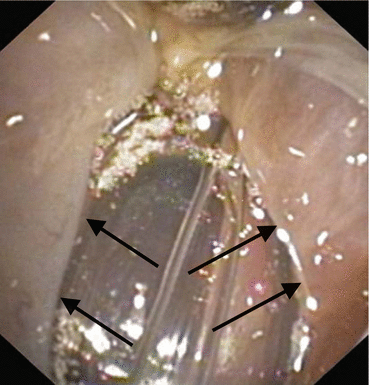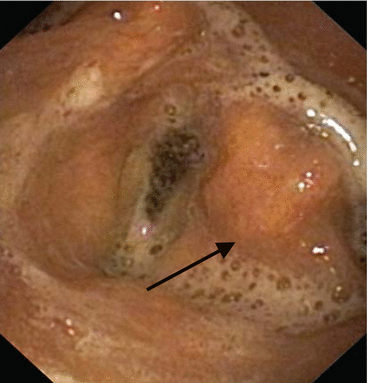, Aida Díaz Redondo2 and Antonio M. Esquinas3
(1)
Intensive Care Unit, Virgen de las Nieves Hospital, Granada, Spain
(2)
Critical Care and Emergency Unit, San Cecilio Hospital, Granada, Spain
(3)
Intensive Care Unit, Morales Meseguer Hospital, Murcia, Spain
Keywords
DysphagiaPost-extubationNoninvasive ventilationPneumonia33.1 Introduction
Dysphagia is defined as a patient-perceived difficulty in swallowing solid and liquid foods. It can manifest in variable forms: from a delay in food bolus formation or movement to pathological displacement with passage of the bolus into the airway. The consequences of dysphagia can be serious and may involve important mortality when dehydration, malnutrition, and/or tracheobronchial aspiration are produced.
The penetration and aspiration of oropharyngeal secretions, food, and gastric contents in the upper bronchial tree give rise to an inflammatory response that stimulates mucosal secretion. This, in turn, gives rise to bronchorrhea and to a series of respiratory alterations ranging from conditions characterized by a good prognosis, such as atelectasis or chemical pneumonitis (Mendelson’s syndrome), to severe respiratory infections or acute respiratory distress syndrome (ARDS) in fragile patients or individuals who are recovering from serious conditions. The risk of bronchoaspiration in patients with oropharyngeal dysphagia is 11 times greater than in patients without swallowing difficulties [7, 8].
The incidence of pharyngeal and laryngeal incompetence in patients with disorders of neuromuscular origin is high, with variations in its frequency of manifestation, severity, and treatment options. Series of patients with disorders as common as cerebrovascular stroke have been reported in which 94 % of the subjects were seen to suffer some degree of dysphagia, in an important number of cases with a good response to conventional rehabilitation therapy. The persistence of dysphagia in these patients was associated with a poorer prognosis, a prolonged hospital stay, and increased admission to homes for the elderly, worsening of quality of life, and dependency for activities of daily living [1].
The incidence of pharyngeal and laryngeal incompetence (typically in the intraglottic/subglottic region) in patients requiring an artificial airway has not been clearly established. Some studies suggest an incidence range from 3 to 62 % in recently extubated patients, that is, post-extubation dysphagia (PED) [2–4]. In a large cohort of critically ill patients, dysphagia (non-neurologic) was present in 84 % of patients and between 50 and 84 % of patients required tracheotomy [1, 2].
Translaryngeal intubation can affect the laryngeal structures as a result of direct impact during intubation, in the course of prolonged intubation, in restless patients, as a consequence of abrasion of the laryngeal mucosa, or secondary to the mere presence of the orotracheal tube. Common findings are vocal cord edema and swelling of the supraglottic space (Fig. 33.1), with a less frequent observation of granulomas at this level. Other infrequent findings are arytenoid subluxation or luxation (Fig. 33.2) or vocal cord paralysis secondary to direct damage or involvement of the recurrent nerves. The orotracheal (translaryngeal) tube keeps the glottis open for prolonged periods of time, abolishing the natural movements of the larynx and of pharyngeal muscles. This, in turn, leads to muscle atrophy, weakness of the pharyngolaryngeal muscles, and stiffness of the tongue, pharynx, hypopharynx, and larynx. The intrinsic movements of the larynx, such as reflex glottic closure during swallowing, are affected. The edema produced as a result of the indwelling foreign body (translaryngeal tube) and the absence of correct stimulation of the laryngeal and hypopharyngeal mechanoreceptors cause a decrease in sensitivity to the presence of secretions, altering the complex swallowing mechanism, which in turn can facilitate laryngeal penetration or tracheal aspiration. The length of time intubated is the most deleterious condition for the development of PED because of muscle atrophy, and impairment of the nerve endings in the glottic and subglottic region, interruption of air passage through the glottis, and the loss of pressure in the subglottic region directly affect the cough reflex, laryngeal adduction, and glottis closing capacity. The glottic and subglottic muscles are affected not only by polyneuropathy in the critical patient but also largely by a lack of use. In fact, restoring air passage through the glottis after extubation or using fenestrated cannulas and/or speaking valves facilitates rehabilitation and posterior recovery from such alterations, in addition to correction of the swallowing and speech mechanisms.



Fig. 33.1
Vocal cord edema

Fig. 33.2
Arytenoid subluxation
The studies conducted to date in relation to laryngeal PED comprise a limited number of heterogeneous patients [4]. In such studies, it is important to note that, hours after intubation, patients may develop laryngeal alterations that can persist for prolonged periods of time. A recent series has reported that in the first 24 h after extubation, 44 % of the patients suffered aspirations not accompanied by cough reflex. In one of the largest series the incidence of PED was 84 %, 17 % of them were classified as severe dysphagia, and moderate 23 %; mild an severe PED was associated independently with the composite outcome of pneumonia, reintubation and death agreeing with other series [3, 4]. The use of simple screening methods or protocolization of the study of such disorders has been shown to be useful, allowing the identification of patients at high risk, with a view to adopting appropriate management measures.
Stay updated, free articles. Join our Telegram channel

Full access? Get Clinical Tree



